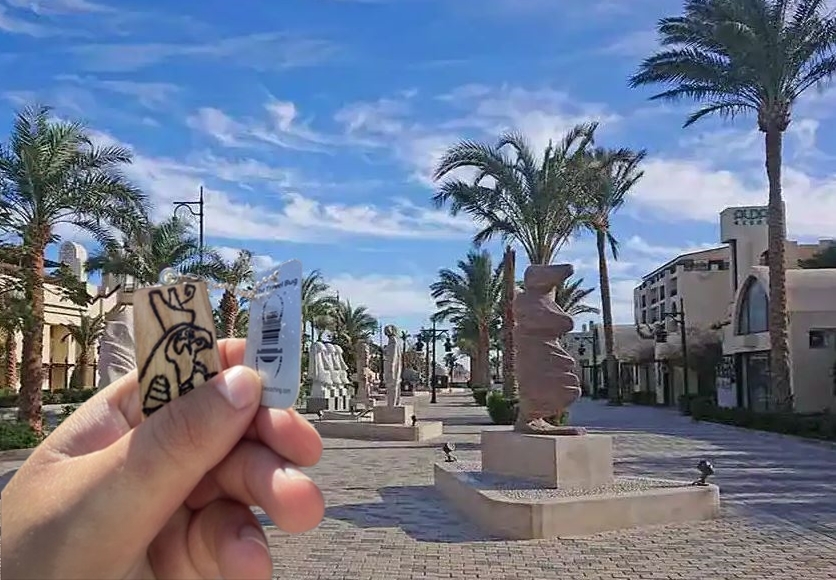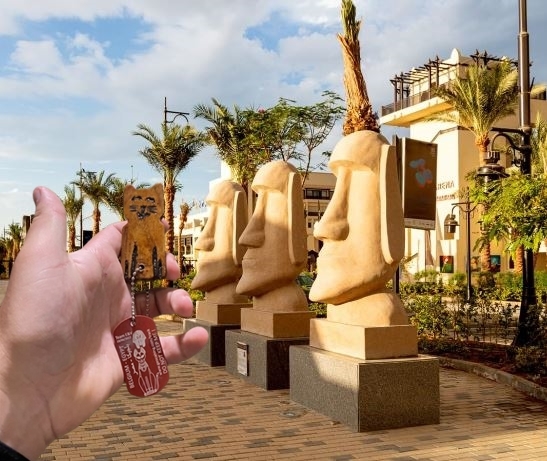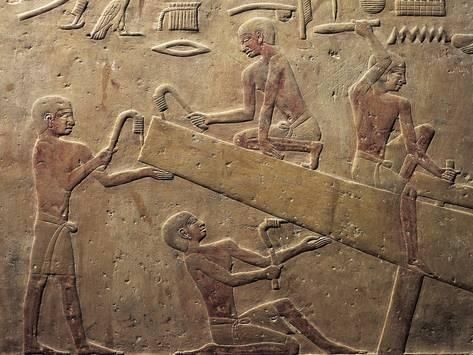Stones from Egyptian soil
(all answers can be found in the listing text or at the location)
Egyptian artists used a wide array of materials, both local and imported, from very early in their history. For instance, already in the Predynastic period we find figurines carved from lapis lazuli—a lustrous blue stone that originates in what is now Afghanistan and indicates the early presence of robust trade routes.

There were numerous native stones used for statuary, including the ubiquitous soft limestone of the desert cliffs that line most of the Nile valley, as well as sandstone, calcite, and schist.
Harder stones include quartzite, diorite, granite, and basalt. Carving on softer stones was done using copper chisels and stone tools; hard stone required tools of yet harder stone, copper alloys, and the use of abrasive sand to shape them. Polishing was achieved with a smooth rubbing stone and abrasive sands with a fine grit.

Painted Statuary
Most statuary was painted; even stones selected for the symbolism of their color were often painted. For instance, the exemplary statues of Menkare, builder of the smallest of the three major pyramids at Giza, were executed in dark schist (also called greywacke). This smooth black stone is connected with Osiris, resurrected god of the dead who was often shown with black or green skin referring to the fertile silt and lush vegetation of the Nile valley.
These images preserve traces of red paint on the king’s skin indicating that, when completed and placed in his memorial temple near his pyramid, they would have appeared lifelike in coloration. With time, the paint would have flaked away, revealing the black stone underneath and explicitly linking the deceased king with the Lord of the Underworld.

At this location, modern artists have used material from mother earth from the Egyptian soil .
HOW TO LOG:
1. Take a picture of yourself + your Travelbug at your favorite stone work and post it to the log.
2. How many different colors of stone do you see at this location ?
3. What type of sone came from the desert cliffs ?
4. what are the 4 names of hard stone ?
5.How many different types of stone do you see at this location ?
"Log this cache "Found" and send me your suggested answers via my profile or via geocaching.com messaging (Message Center), and I will contact you if there is a problem."

------------------------------------------------------------------------------------------------------------------------------------------------------
Ägyptischer Boden
(alle Antworten finden Sie im Auflistungstext oder am Standort)
Ägyptische Künstler verwendeten schon sehr früh in ihrer Geschichte eine breite Palette von Materialien, sowohl lokale als auch importierte. So finden wir beispielsweise bereits in prädynastischer Zeit aus Lapislazuli geschnitzte Figuren – ein glänzender blauer Stein, der aus dem heutigen Afghanistan stammt und auf das frühe Vorhandensein robuster Handelswege hinweist.

Es gab zahlreiche einheimische Steine, die für Statuen verwendet wurden, darunter der allgegenwärtige weiche Kalkstein der Wüstenklippen, die den größten Teil des Niltals säumen, sowie Sandstein, Calcit und Schiefer.
Zu den härteren Steinen gehören Quarzit, Diorit, Granit und Basalt. Das Schnitzen auf weicheren Steinen erfolgte mit Kupfermeißeln und Steinwerkzeugen; Harter Stein erforderte Werkzeuge aus noch härterem Stein, Kupferlegierungen und die Verwendung von Schleifsand, um sie zu formen. Das Polieren wurde mit einem glatten Schleifstein und Schleifsand mit feiner Körnung erreicht.

Bemalte Statuen
Die meisten Statuen wurden gemalt; Sogar Steine, die wegen der Symbolik ihrer Farbe ausgewählt wurden, wurden oft bemalt. So wurden die beispielhaften Statuen von Menkare, dem Erbauer der kleinsten der drei großen Pyramiden von Gizeh, in dunklem Schiefer (auch Grauwacke genannt) ausgeführt. Dieser glatte schwarze Stein ist mit Osiris verbunden, dem auferstandenen Gott der Toten, der oft mit schwarzer oder grüner Haut dargestellt wurde, was auf den fruchtbaren Schlick und die üppige Vegetation des Niltals hinweist.
Diese Bilder bewahren Spuren von roter Farbe auf der Haut des Königs, was darauf hinweist, dass sie, wenn sie fertiggestellt und in seinem Gedenktempel in der Nähe seiner Pyramide platziert wurden, in ihrer Färbung lebensecht erschienen wären. Mit der Zeit wäre die Farbe abgeplatzt, hätte den schwarzen Stein darunter freigelegt und den verstorbenen König eindeutig mit dem Herrn der Unterwelt in Verbindung gebracht.
ANMELDUNG:
1.Machen Sie ein Foto von sich und Ihrem Travelbug bei Ihrer Lieblingssteinarbeit und posten Sie es im Protokoll.
2.Wie viele verschiedene Steinfarben sehen Sie an diesem Ort?
3. Welche Art von Sone stammt von den Wüstenklippen?
4. Was sind die 4 Namen von Hartgestein?
5.Wie viele verschiedene Steinarten sehen Sie an diesem Ort?
"Logge diesen Cache als "Gefunden" und sende mir deine vorgeschlagenen Antworten über mein Profil oder über das Messaging von geocaching.com (Message Center), und ich werde dich kontaktieren, wenn es ein Problem gibt."

---------------------------------------------------------------------------------------------------------------------------------------------------------------------
استخدم الفنانون المصريون مجموعة واسعة من المواد ، المحلية منها والمستوردة ، منذ وقت مبكر جدًا من تاريخهم. على سبيل المثال ، وجدنا بالفعل في فترة ما قبل الأسرات تماثيل منحوتة من اللازورد - وهو حجر أزرق لامع نشأ في ما يعرف الآن بأفغانستان ويشير إلى الوجود المبكر لطرق التجارة القوية.
 كان هناك العديد من الأحجار الأصلية المستخدمة في صناعة التماثيل ، بما في ذلك الحجر الجيري الناعم في كل مكان من المنحدرات الصحراوية التي تصطف على معظم وادي النيل ، وكذلك الحجر الرملي والكالسيت والشست.
تشمل الأحجار الأكثر صلابة الكوارتزيت والديوريت والجرانيت والبازلت. تم النحت على أحجار أكثر ليونة باستخدام الأزاميل النحاسية والأدوات الحجرية ؛ تتطلب الأحجار الصلبة أدوات من الحجر الصلب ، وسبائك النحاس ، واستخدام الرمل الكاشطة لتشكيلها. تم التلميع باستخدام حجر فرك ناعم ورمال كاشطة بحبيبات ناعمة.
كان هناك العديد من الأحجار الأصلية المستخدمة في صناعة التماثيل ، بما في ذلك الحجر الجيري الناعم في كل مكان من المنحدرات الصحراوية التي تصطف على معظم وادي النيل ، وكذلك الحجر الرملي والكالسيت والشست.
تشمل الأحجار الأكثر صلابة الكوارتزيت والديوريت والجرانيت والبازلت. تم النحت على أحجار أكثر ليونة باستخدام الأزاميل النحاسية والأدوات الحجرية ؛ تتطلب الأحجار الصلبة أدوات من الحجر الصلب ، وسبائك النحاس ، واستخدام الرمل الكاشطة لتشكيلها. تم التلميع باستخدام حجر فرك ناعم ورمال كاشطة بحبيبات ناعمة.
 التماثيل المرسومة
تم رسم معظم التماثيل ؛ حتى الأحجار المختارة لرمزية لونها غالبًا ما يتم رسمها. على سبيل المثال ، تم إعدام التماثيل النموذجية لمنكاري ، باني أصغر الأهرامات الثلاثة الرئيسية في الجيزة ، في شست الظلام (وتسمى أيضًا جرايواك). يرتبط هذا الحجر الأسود الأملس بأوزوريس ، إله الموتى المُقام من الموت والذي غالبًا ما كان يظهر بجلد أسود أو أخضر يشير إلى الطمي الخصب والنباتات المورقة في وادي النيل.
تحتفظ هذه الصور بآثار من الطلاء الأحمر على جلد الملك مما يشير إلى أنه عند اكتمالها ووضعها في معبده التذكاري بالقرب من هرمه ، كانت ستبدو نابضة بالحياة في التلوين. بمرور الوقت ، كان من الممكن أن يتلاشى الطلاء ، ويكشف عن الحجر الأسود تحته ويربط صراحةً الملك المتوفى بلورد العالم السفلي.
في هذا الموقع ، استخدم الفنانون المعاصرون مواد من الأرض الأم من التربة المصرية.
كيفية التسجيل:
1. كم عدد أنواع الحجر المختلفة التي تراها في هذا الموقع؟
2. ما نوع الحجر هي الرؤوس الثلاثة؟
3. ما نوع الصوت الذي جاء من منحدرات الصحراء؟
4. ما هي الأسماء الأربعة للحجر الصلب؟
5. التقط صورة لنفسك + Travelbug في أعمالك الحجرية المفضلة وانشرها في السجل. (اختياري)
التماثيل المرسومة
تم رسم معظم التماثيل ؛ حتى الأحجار المختارة لرمزية لونها غالبًا ما يتم رسمها. على سبيل المثال ، تم إعدام التماثيل النموذجية لمنكاري ، باني أصغر الأهرامات الثلاثة الرئيسية في الجيزة ، في شست الظلام (وتسمى أيضًا جرايواك). يرتبط هذا الحجر الأسود الأملس بأوزوريس ، إله الموتى المُقام من الموت والذي غالبًا ما كان يظهر بجلد أسود أو أخضر يشير إلى الطمي الخصب والنباتات المورقة في وادي النيل.
تحتفظ هذه الصور بآثار من الطلاء الأحمر على جلد الملك مما يشير إلى أنه عند اكتمالها ووضعها في معبده التذكاري بالقرب من هرمه ، كانت ستبدو نابضة بالحياة في التلوين. بمرور الوقت ، كان من الممكن أن يتلاشى الطلاء ، ويكشف عن الحجر الأسود تحته ويربط صراحةً الملك المتوفى بلورد العالم السفلي.
في هذا الموقع ، استخدم الفنانون المعاصرون مواد من الأرض الأم من التربة المصرية.
كيفية التسجيل:
1. كم عدد أنواع الحجر المختلفة التي تراها في هذا الموقع؟
2. ما نوع الحجر هي الرؤوس الثلاثة؟
3. ما نوع الصوت الذي جاء من منحدرات الصحراء؟
4. ما هي الأسماء الأربعة للحجر الصلب؟
5. التقط صورة لنفسك + Travelbug في أعمالك الحجرية المفضلة وانشرها في السجل. (اختياري)

